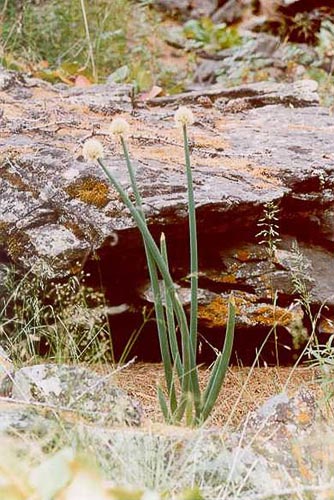Relatives
Allium altaicum Pallas - Altai onion.
Taxonomic position.
Family Alliaceae J.Agardh, genus Allium L.Synonyms.
A. fistulosum auct. non L., A. microbulbum. Prokh.Stone onion, wild spring onion, tatarka.
Morphology and biology.
Grassy, perennial, bulbous plant. One or several on a rhizome, bulbs are oblong-ovate with reddish-brown, thin-skinned, solid coats. Stalk is 25-80 cm in length, vigorous, fistular, swollen in the middle. Leaves are fistular, 2-4 in number. Umbel is globular, polyanthous, capitate. Tepals are 6-8 mm long, yellowish, shining, pointed. Filaments are much longer than perianth. Morphological variation is observed in bulb size, pedicel length, filament length, etc. Blossoms in June/July, bears fruit in July/August. Entomophilous. Autochore. 2n=16.Distribution.
Asian species: Siberia (Altai, Sayan Mountains, Tuva, Trans-Baikal region), Middle Asia (Dzungarian Ala Tau, Tarbagatai), Far East (Amur River, 30 km above Ignashino Village), Mongolia, and China.Ecology.
Grows predominantly in dry, rocky habitats, on rocks and on rubbly taluses in sub-Alpine mountain zones (1900-2400 m).Utilization and economic value.
Used as a table vegetable and a source of vitamins. Very promising for in the field of plant breeding as a source of powdery mildew resistance genes. Progenitor of the cultivated Welsh onion.References:
Brezhnev, D.D., Korovina, O.N. 1981. Wild relatives of cultivated plants in the flora of the USSR. Leningrad: Kolos, 375 pp. (in Russian).Frizen, N.V. 1988. Onions plants of Siberia. Novosibirsk: Nauka, p.157 (in Russian).
Kazakova, A.A. 1978. Onion. (Cultivated Flora of the USSR. Vol. 10). Leningrad: Kolos, 262 pp. (in Russian).
Kharkevich S.S., ed. 1988. Vascular plants of the Soviet Far East. Vol. 2. Leningrad: Nauka, 445 p. (in Russian).Malyshev L.I., Peshkova G.A., eds. 1987. Flora of Siberia. Araceae - Orchidaceae. V. 4. Novosibirsk: Nauka, pp.93-94 (in Russian).


